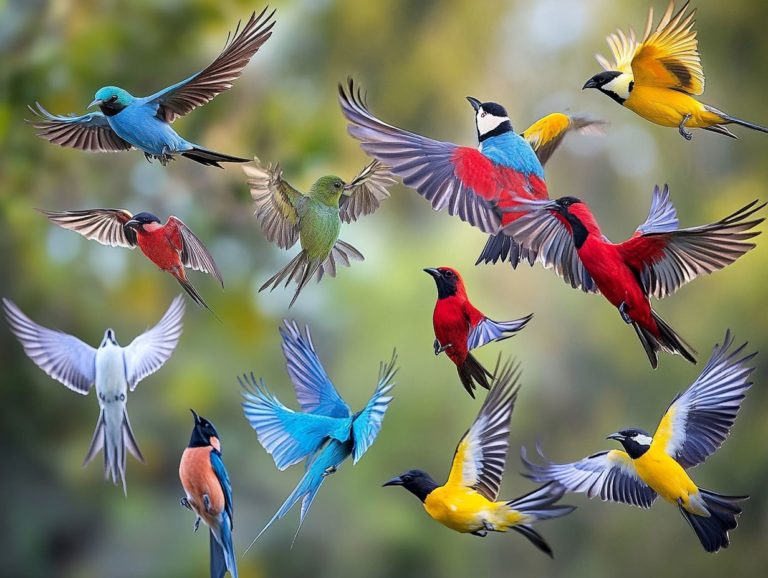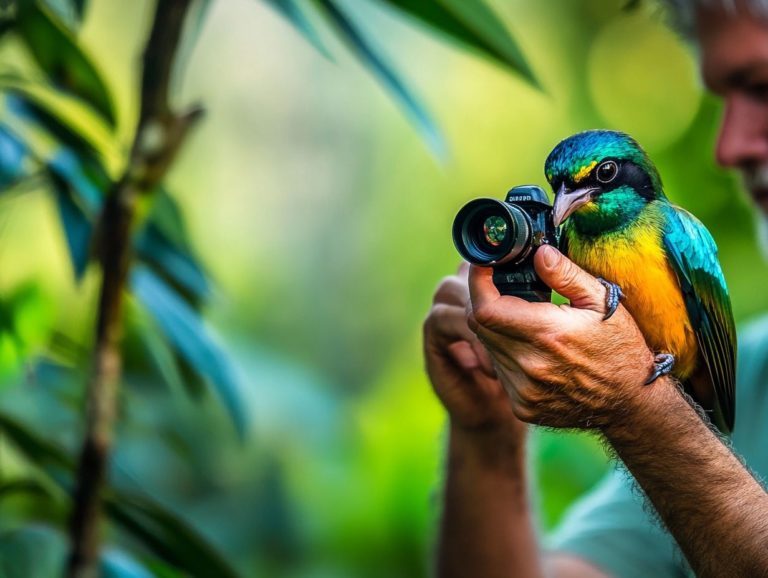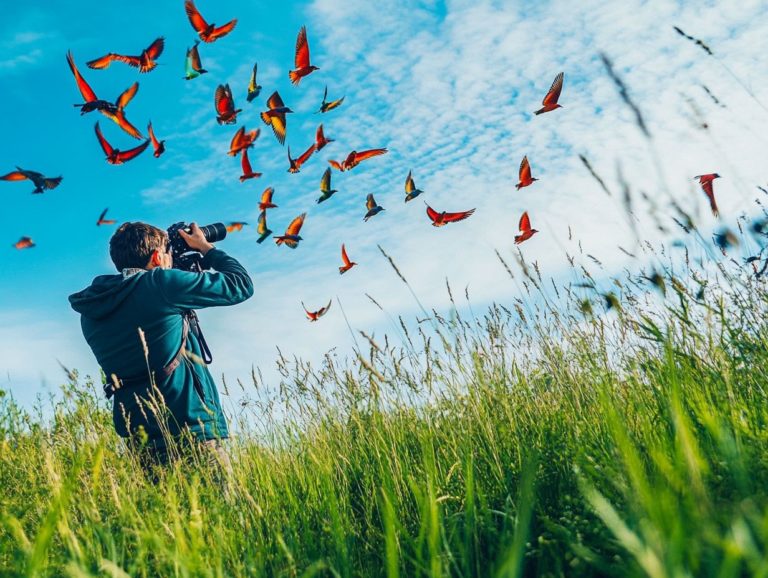Top 5 Birdwatching Photography Gear Reviews
Bird photography is a captivating pursuit that truly deserves your attention! Having the right gear is essential for capturing the stunning beauty of our feathered friends.
Whether you re a weekend hobbyist or a seasoned professional, choosing the ideal camera, lens, tripod, and accessories can transform your shots into something extraordinary.
Get ready to discover the top five must-have items for bird photography! This article provides essential tips and features to consider as you build your kit.
Prepare to elevate your photography and enrich your birdwatching adventures like never before!
Contents
- Key Takeaways:
- 1. Best Camera for Bird Photography
- 2. Best Lens for Bird Photography
- 3. Best Tripod for Bird Photography
- 4. Best Camera Bag for Bird Photography
- 5. Best Accessories for Bird Photography
- What Makes a Good Bird Photography Gear?
- What Are the Key Features to Look for in a Camera?
- What Are the Different Types of Lenses and Their Uses?
- How Can a Tripod Improve Bird Photography?
- What Are the Essential Items to Carry in a Camera Bag?
- How Do Accessories Enhance Bird Photography?
- What Are the Pros and Cons of Different Bird Photography Gear?
- How Can One Choose the Right Gear for Their Budget?
- What Are Some Tips for Maintaining and Protecting Bird Photography Gear?
- How Can One Upgrade Their Gear as They Advance in Bird Photography?
- What Are Some Common Mistakes to Avoid When Purchasing Bird Photography Gear?
- Frequently Asked Questions
- What are the top 5 must-have gear for birdwatching photography?
- Which DSLR camera is best for birdwatching photography?
- What is the ideal telephoto lens for birdwatching photography?
- Why is a tripod important for birdwatching photography?
- What should I look for in a camera bag for birdwatching photography?
- Is it necessary to have a large memory card for birdwatching photography?
Key Takeaways:

- The camera is the most important gear for bird photography. Look for features like fast focusing, high resolution, and the ability to take many pictures quickly in a row.
- Lenses play a crucial role in capturing detailed and sharp images of birds. Choose a telephoto lens with a long focal length for better reach.
- A sturdy tripod is essential for sharp and stable bird photographs. Look for affordable options that are lightweight, durable, and adjustable for ease of use in the field.
1. Best Camera for Bird Photography
Choosing the right camera is essential for capturing breathtaking images of wildlife in action! This is especially true for you as a professional photographer who seeks high focusing performance and rapid shooting speed.
Full-frame mirrorless options like the Canon EOS R3, Nikon Z9, and Sony A1 are your best allies. They are equipped with the features you need to excel in bird-in-flight photography and bird detection, ensuring you never miss that perfect moment.
Each model presents unique attributes designed to tackle the specific challenges of this genre. For example, the Canon EOS R3 offers real-time animal detection and impressive shooting speeds, making it an outstanding choice for fast-moving subjects.
The Nikon Z9 excels with its dual card slots and high-resolution capabilities, vital for capturing detailed images under varying lighting conditions. Meanwhile, the Sony A1 differentiates itself with advanced focusing tracking and exceptional low-light performance, allowing you to seize remarkable shots during the magical hours of dawn or dusk when birds are most active!
Understanding these nuances will enable you to make informed decisions that align with your shooting style and environment!
2. Best Lens for Bird Photography
The choice of lens can profoundly influence the quality of your bird photography! It s essential for both amateur and professional photographers alike to select lenses that enhance their ability to capture breathtaking images especially in dynamic scenarios like bird-in-flight photography.
Brands like Canon, Nikon, and Sony provide a variety of lenses designed to excel in this niche, including budget-friendly options that deliver high-resolution images without straining your wallet.
Among the lens types, telephoto and prime lenses often take the spotlight for their remarkable ability to bring distant subjects into sharp focus. Telephoto lenses, with their longer focal lengths, are perfect for capturing intricate details of birds in their natural habitats without causing any disruption!
On the other hand, prime lenses frequently offer wider apertures, enhancing performance in low-light conditions. It s crucial to understand that a longer focal length can effectively isolate your subjects against busy backgrounds.
Additionally, considering a lens s maximum aperture is vital, as it plays a significant role in improving overall image quality. For those dedicated to bird detection and bird tracking, models such as the Canon EF 100-400mm f/4.5-5.6L IS II and Nikon AF-S 200-500mm f/5.6E are esteemed for their sharpness and rapid focusing capabilities!
Choose your gear wisely, and start capturing stunning bird photos today!
3. Best Tripod for Bird Photography
A sturdy tripod is essential for bird photography. It provides stability to help capture stunning images and minimize camera shake during longer sessions, especially when you’re using heavier lenses.
You’ll find lightweight and portable tripods designed specifically for bird photography at various price points. This ensures that both seasoned professionals and passionate enthusiasts can discover affordable options that cater to their unique needs.
When shopping for a tripod, pay close attention to the material. Carbon fiber models are favored for their impressive strength and lightweight design, which is crucial for extended hikes in pursuit of elusive birds.
The ability to adjust the height quickly is another feature that allows you to shift your shooting angle with ease, maximizing your versatility in any setting.
Consider popular options like the Manfrotto Befree Series and Gitzo Ranger tripods. These models are known for durability and user-friendliness.
Whether you prefer a compact setup for hiking or a more robust design for studio work, these tripods are crafted to enhance your bird photography experience with functionalities tailored to your style.
4. Best Camera Bag for Bird Photography
A well-designed camera bag is essential for any bird photographer. It ensures your photography gear remains organized, protected, and easily accessible in the field.
The best camera bags for bird photography strike the perfect balance between lightweight portability and ample storage space for your lenses, tripods, and other accessories. This makes them critical whether you’re a seasoned professional or a passionate enthusiast.
With various styles like backpacks, shoulder bags, and belt systems, you can choose the option that best suits your shooting style and personal preferences.
For instance, a backpack offers comfortable support during long hikes, while a shoulder bag allows for quick access to your gear when you need to capture fleeting moments.
Essential features like weather resistance protect your equipment against unexpected rain. Generous padding also safeguards it from bumps and drops.
Easy access to your gear can significantly enhance your shooting experience, allowing you to transition seamlessly from one shot to the next.
By understanding the different options and their standout features, you can make a well-informed decision tailored to your unique adventures.
5. Best Accessories for Bird Photography
To elevate your bird photography skills, investing in the right accessories can transform your experience and the quality of your shots. Must-have tools like filters, remote shutter releases, and cleaning kits can boost your workflow.
AI-driven features in some cameras can help detect and track birds, ensuring you capture every fleeting moment. A sturdy tripod is invaluable for stability when shooting with heavier lenses.
This not only results in sharper images but also allows for better composition. A well-designed camera backpack keeps your equipment organized and readily accessible while navigating through dense woods or quietly observing from a birdwatching platform.
Teleconverters are devices that magnify the camera’s lens to photograph distant birds without sacrificing image quality. The choice of accessories should reflect your personal photography style.
Whether you favor high-speed action shots or serene portraits in natural light, choose accessories that adapt seamlessly to your environment and technique. Invest in these accessories today to take your bird photography to the next level!
What Makes a Good Bird Photography Gear?
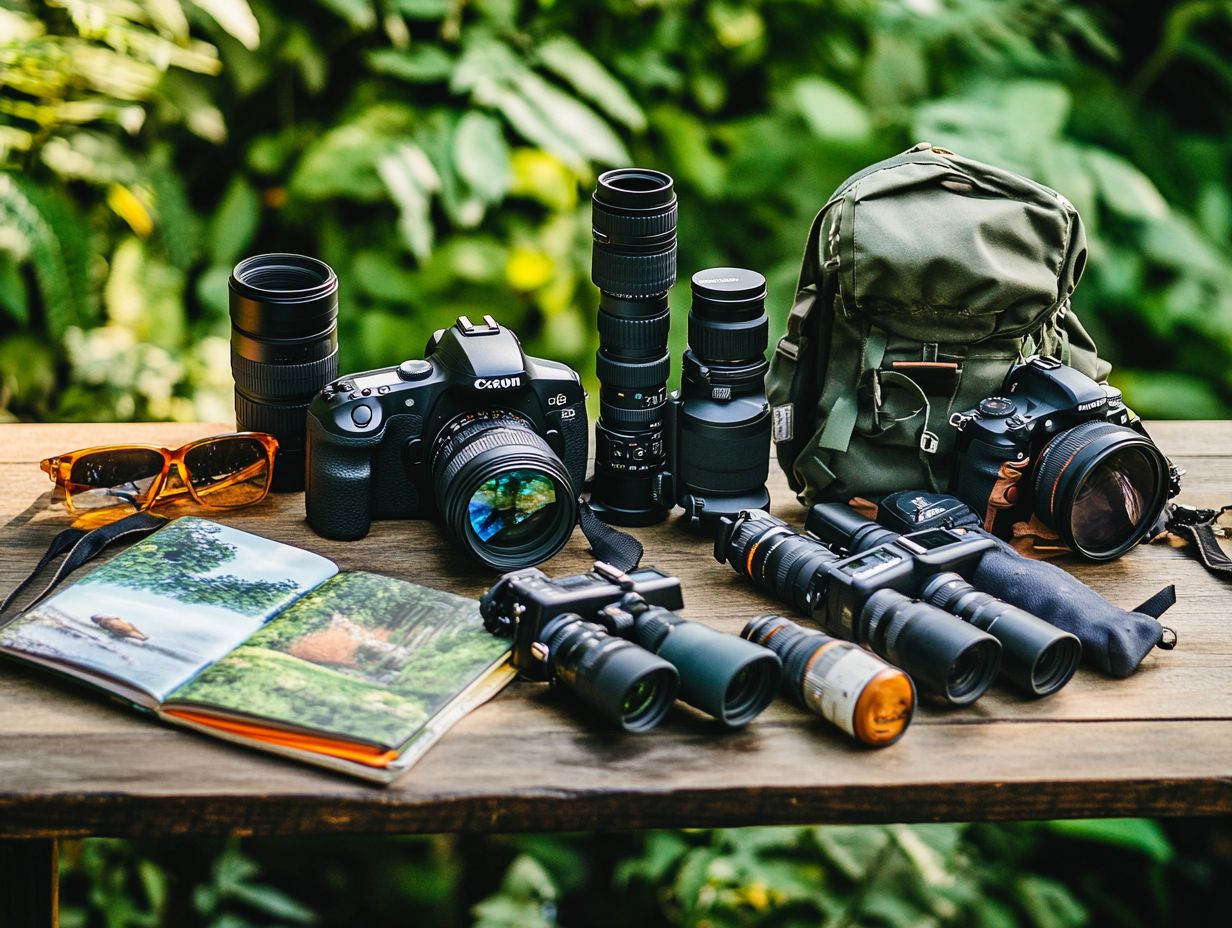
Good bird photography gear is all about delivering high-quality images with precision and speed. Whether you’re an amateur or a seasoned pro, having the right tools, including innovative binoculars for bird watching, is essential for your passion for capturing wildlife.
Look for key features like superior autofocus performance, high-speed shooting capabilities, and advanced subject detection technologies. These elements allow you to track birds effectively, no matter the environment or lighting conditions.
The choice of camera body is crucial. A model with higher light sensitivity will serve you well in low light. Additionally, a durable build ensures it can handle the challenges of outdoor settings.
Lens quality plays a significant role in achieving image sharpness and clarity. Long telephoto lenses are often the go-to for reaching distant subjects.
You’ll be amazed at how much portability matters; lightweight gear makes it easier for you to hike for hours, always ready for that perfect shot. Customizing your gear to match your shooting style and the environments you explore can truly elevate your bird photography experience. For those looking to enhance their photos, checking out the top editing software for bird images can help you capture stunning moments in nature.
What Are the Key Features to Look for in a Camera?
When selecting a camera for bird photography, it s essential to focus on key features that will elevate your ability to capture breathtaking images, especially in fast-paced environments.
Prioritize attributes like rapid autofocus performance, a high-resolution sensor, and the benefits of mirrorless cameras. These cameras don t have a mirror mechanism, allowing for lighter designs and faster shooting, which is crucial for capturing birds in flight.
Weather sealing is important, especially in unpredictable outdoor conditions. A wide aperture lens is also essential, as it enhances subject isolation and performs remarkably in low-light situations think early mornings or late evenings when the light can be tricky.
For both enthusiasts and professionals, options like the Canon EOS R5 and Nikon Z9 deliver outstanding autofocus technology and high frame rates. You can also rely on DSLR alternatives such as the Canon EOS 7D Mark II and Nikon D500, which remain reliable choices for robust performance, even in the most demanding shooting scenarios.
What Are the Different Types of Lenses and Their Uses?
Understanding the various types of lenses available for bird photography is crucial for achieving outstanding results. Each lens type has its own set of advantages tailored to specific shooting scenarios.
For example, telephoto lenses are your go-to for capturing distant subjects, while prime lenses deliver superior image quality. Versatile zoom lenses, on the other hand, offer the flexibility to adapt to different situations seamlessly.
As a bird photographer, you ll often find yourself in moments that demand quick adjustments, making your knowledge of these lenses invaluable. Take, for instance, the Canon EF 600mm f/4L IS III USM. This high-quality telephoto lens excels at bringing distant wildlife into sharp focus, allowing you to observe elusive species without disturbing their natural habitat.
Then there are prime lenses like the Nikon AF-S NIKKOR 300mm f/4E PF ED VR. They offer remarkable clarity and impressive low-light performance, making them perfect for those enchanting early morning or late afternoon shoots.
Alternatively, consider a zoom lens like the Sony FE 100-400mm f/4.5-5.6 GM OSS. This lens provides the flexibility to adjust your framing swiftly, catering to the unpredictable movements and varying distances of your feathered subjects.
How Can a Tripod Improve Bird Photography?
Using a tripod in bird photography is very helpful. It enhances stability, allowing you to capture sharper images, especially in challenging conditions or with heavy lenses.
The right tripod significantly reduces camera shake and enables longer exposures, ensuring your shots are crisp and detailed.
In low-light environments, where fleeting moments can be a challenge, a sturdy tripod becomes essential. It allows for slower shutter speeds without introducing blur, dramatically improving your photographs’ overall quality.
When using telephoto lenses, the added weight can strain your handheld shooting. Therefore, investing in a tripod with features like adjustable leg locks and a sturdy head is crucial.
Consider options such as:
- A ball head for quick adjustments
- A gimbal head (a type of tripod head that allows for smooth movement) for tracking moving subjects
For bird photographers on the move, a lightweight, portable tripod is recommended for long days in the field. A more robust model is the best choice for studio work or fixed locations.
What Are the Essential Items to Carry in a Camera Bag?
Packing the right essentials can supercharge your bird photography! Key items to include are:
- extra batteries
- memory cards
- lens cleaning kits
- versatile accessories to enhance your experience.
Having extra batteries on hand is essential; the thrill of capturing fleeting moments can drain power faster than you might expect. Likewise, additional memory cards ensure you have plenty of storage for spontaneous bursts of avian activity.
A lens cleaning kit is crucial for maintaining image clarity, preventing dust or water spots from ruining your hard-earned shots. A sturdy tripod or a lightweight monopod stabilizes your setup, allowing you to achieve sharp images even in challenging lighting conditions.
Every item you pack not only aids in capturing stunning photographs but also equips you to handle the unpredictable nature of birdwatching, making each outing more enjoyable and rewarding.
How Do Accessories Enhance Bird Photography?
Accessories are essential for elevating your bird photography, providing you with tools that enhance the quality of your shots and streamline your workflow. Filters can effectively manage light and contrast, while remote shutter releases ensure shake-free shooting, and cleaning kits keep your gear in impeccable condition.
Specialized lenses, like telephoto zooms, allow you to capture clear and vibrant details from a distance without disturbing your subjects. A sturdy tripod stabilizes your camera, making longer shooting sessions in low-light conditions easier.
Investing in camouflage gear enables you to blend seamlessly into your surroundings, increasing your chances of observing birds in their natural habitats. These accessories enrich your experience as a photographer and lead to superior images, helping you tackle common challenges like shaky hands and limited access to distant wildlife.
What Are the Pros and Cons of Different Bird Photography Gear?
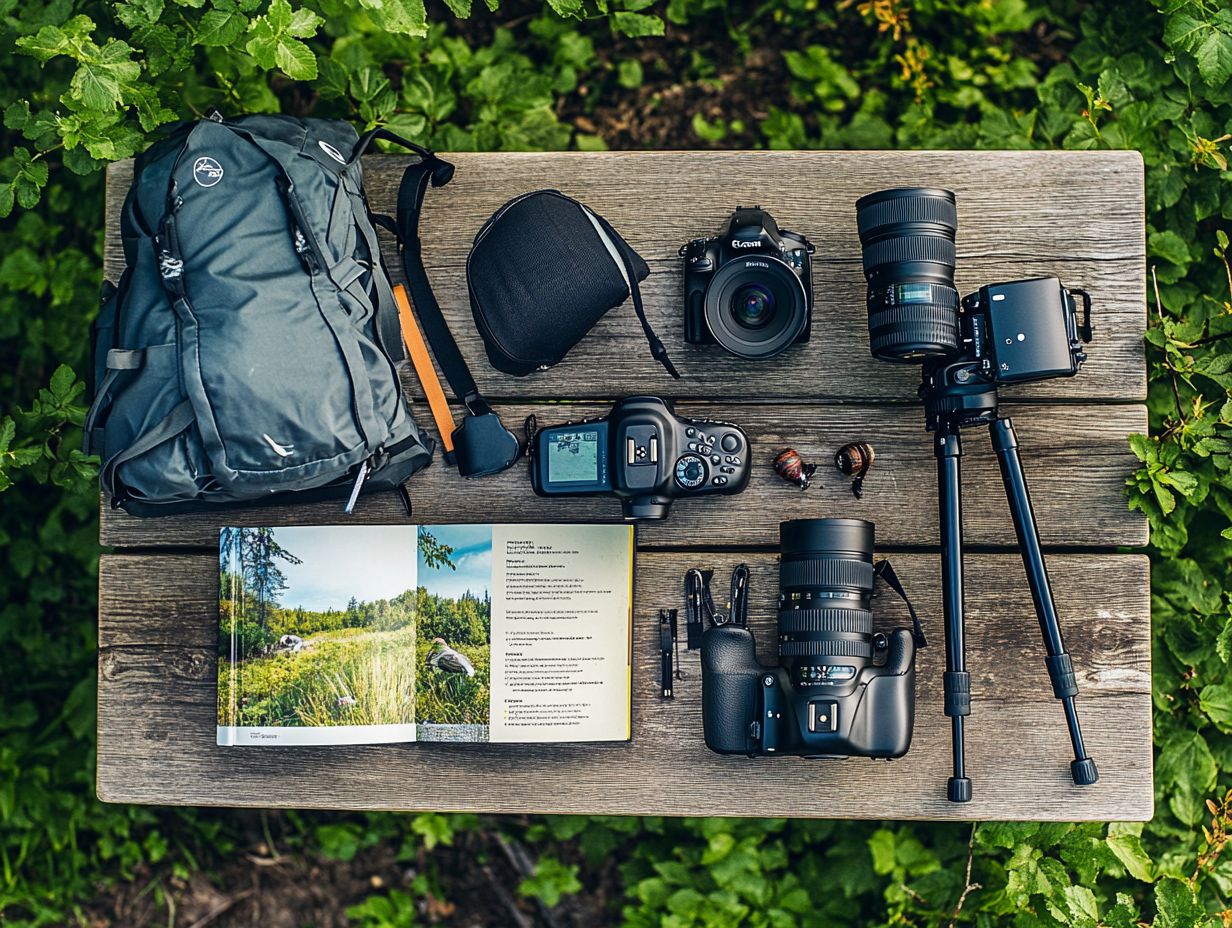
Understanding the pros and cons of various bird photography gear is crucial for making informed purchasing decisions that cater to your unique needs and budget. For those looking to enhance their skills, checking out the top bird photography apps reviewed can provide valuable insights. Each type of camera, lens, and accessory has its advantages and drawbacks, significantly influencing both your photography experience and the quality of your final images.
For example, while DSLRs are known for their robust build and impressive battery life, mirrorless cameras focus quickly and are lighter to carry, ideal for long hours spent in the field.
The choice between telephoto, prime, and zoom lenses can also shape your shooting style. Telephoto lenses are great for capturing distant subjects with clear and vibrant details, while prime lenses excel in low light, delivering sharp images.
On the other hand, zoom lenses offer the versatility you need, allowing for quick adjustments as birds move unpredictably. By carefully evaluating these factors, you can determine the best fit for capturing breathtaking images of wildlife, whether they re soaring through the sky or perched gracefully.
Start exploring these essential items today for incredible bird photography adventures!
How Can One Choose the Right Gear for Their Budget?
Choosing the right gear for bird photography on a budget can feel like navigating a labyrinth. However, with some thoughtful consideration and research, including understanding the top features in bird watching binoculars, you can find affordable gear without sacrificing quality.
By honing in on essential features and staying attuned to market trends, you can make informed choices that elevate your bird photography experience without breaking the bank. Focus on aspects like lens versatility, image stabilization (a feature that helps reduce blurriness in your photos caused by camera shake), and lightweight construction.
A solid zoom lens, like a 70-300mm, gives you both reach and flexibility, making it perfect for capturing elusive distant subjects. Brands such as Tamron and Sigma often provide budget-friendly alternatives that deliver impressive optical performance.
Don’t ignore second-hand markets; gently used equipment can offer significant savings while still achieving fantastic results. By strategically balancing quality with cost, you’ll be ready to dive into exciting birdwatching adventures, fully equipped to capture stunning imagery.
What Are Some Tips for Maintaining and Protecting Bird Photography Gear?
Proper maintenance and protection of your bird photography gear are essential for ensuring longevity and optimal performance. This allows you to capture stunning images without interruption.
Regular cleaning, appropriate storage, and protective cases are crucial practices that help safeguard your investment in photography equipment. By implementing simple yet effective cleaning techniques, like using a microfiber cloth to wipe down your lenses and camera bodies regularly, you can prevent dirt and dust accumulation, ensuring clarity in your shots.
Utilizing padded bags specifically designed for this purpose not only provides physical protection but also helps manage temperature and humidity fluctuations. Weather protection is equally important; using rain covers or opting for weather-sealed gear can make a significant difference in challenging environments.
Understanding how to tailor your gear preparation for various ecosystems whether it s navigating saltwater conditions or rugged terrains ensures that every outing is met with reliability and readiness.
How Can One Upgrade Their Gear as They Advance in Bird Photography?
As you advance in your bird photography skills, upgrading your gear becomes essential for capturing high-quality images and tackling more challenging shots. Knowing when and how to invest in better equipment is crucial for any professional photographer looking to elevate their work and refine their craft.
This decision often arises from a noticeable shift in your skill level perhaps you ve developed greater technical proficiency or a change in focus, such as transitioning from casual wildlife photography to pursuing elusive species in their natural habitats.
If you re missing great shots, it s time to upgrade. Investing in a faster lens can significantly enhance your low-light photography, while a more advanced camera body with superior autofocus capabilities can help you track fast-moving subjects with ease.
Don’t overlook the importance of upgrading your accessories, too. A sturdy tripod or a well-designed bag can enhance your mobility and stability, allowing you to adapt to various environments and effectively capture the nuances of avian life.
What Are Some Common Mistakes to Avoid When Purchasing Bird Photography Gear?
When you’re looking to purchase bird photography gear, there are several common missteps that can lead to frustration and wasted money. Learning about your options, such as the top 5 stylish birding backpacks for 2024, is the first step to great bird photography!
Avoiding pitfalls like over-investing in unnecessary features or neglecting to test gear in real-world conditions can significantly enhance your photography experience.
Many photographers overlook the importance of knowing what you need for your photography whether it s capturing fast-flying species or photographing perched birds at a distance. Researching which lenses offer the best reach and clarity, along with ensuring compatibility with your existing gear, can save you both time and money.
Hands-on testing at a local store or borrowing equipment from fellow photographers can provide invaluable insights into how different gear performs in various settings. By prioritizing practicality and your personal requirements over flashy specifications, you can make thoughtful purchases that genuinely elevate your photography.
Watch this video to learn more about bird photography gear.
Frequently Asked Questions
What are the top 5 must-have gear for birdwatching photography?

The top 5 essential gear for birdwatching photography are a DSLR camera, a telephoto lens, a tripod, a camera bag, and a memory card with ample storage. For those looking to enhance their experience, check out the top 5 essential accessories for bird watching.
Which DSLR camera is best for birdwatching photography?
The best DSLR camera for birdwatching photography is the Canon EOS 90D, known for its fast autofocus and high-resolution images.
What is the ideal telephoto lens for birdwatching photography?
The ideal telephoto lens for birdwatching photography is the Nikon AF-S NIKKOR 200-500mm f/5.6E ED VR, praised for its long reach and sharp images.
Why is a tripod important for birdwatching photography?
A tripod is essential for birdwatching photography as it provides stability, allowing for longer exposure times and resulting in sharper images.
What should I look for in a camera bag for birdwatching photography?
When looking for a camera bag, ensure it is lightweight, has waterproof protection, and can comfortably fit all your gear.
Is it necessary to have a large memory card for birdwatching photography?
It is recommended to have a large memory card for birdwatching photography since birds can be unpredictable, and you may take more photos than anticipated.
Have you made any mistakes while purchasing bird photography gear? Share your experiences or tips with us!

